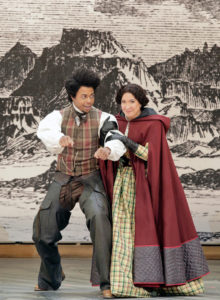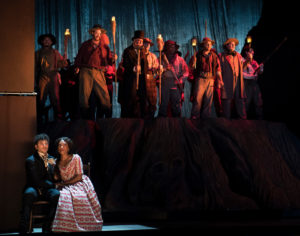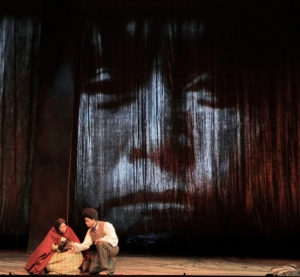In the first act of Girls of the Golden West a huge gold frame descends to the stage and a black-and-white engraving of wilderness appears in its center. A stagehand in black turns a crank moving the spools that wind the picture along until another engraving replaces it. This special effect, the moving panorama, was popular in the mid 19th-century. And it’s not a bad metaphor for John Adams and Peter Sellars’ new opera Girls of the Golden West. For although the moving panorama gives the illusion of action and expansiveness, the opera is often strangely static.

The question is: why? For there is so much that is right about the opera, in concept and certainly in the excellence of the talents involved – all of them. The singers are wonderful, the chorus vigorous, the orchestra, under the direction of Grant Gershon, superlative.
Sellars and Adams chose to present California in its early days as a state in 1850–1851. In the midst of the gold rush, the state was drawing fortune seekers from around the world. A former Spanish colony California was now becoming a state in a country devoted to American conquest. Violence, poverty and racism accompanied this transformation, as the Native American, Mexican and Chinese populations were exterminated or subordinated.
To present this historical moment Sellars and Adams created a libretto composed of writing from the period. This is a technique they’ve used before; most successfully in the 2005 opera Dr. Atomic. The libretto combines text from the letters of Louise Clappe, Frederick Douglass, Ramón Gil Navarro, Argentine poet Alfonsina Storni, Chinese poetry, Mark Twain, William Shakespeare(!) and miners’ songs. All of these, however, in the context of the opera’s action become narratives in the past tense, so the action is told as events that have occurred, rather than as taking place.
And often the staging emphasizes the text’s quality of presenting evidence. When Julia Bullock as Louise Clappe, aka Dame Shirley, describes the furniture in her cabin – the tables and shelves made from odd bits of boxes and suitcases, the fireplace constructed of tin cans – a line of miners place the objects in front of her in a kind of three-dimensional illustration. The idea and its presentation are charming but nonetheless passive; somehow removed from dramatic vitality.

There are many reasons, however, to construct the text as collage. Some of the words are lyrically beautiful. Dame Shirley’s description of her encounter with a group of semi-naked Native American women is haunting, and consequently one of the more moving sections of the opera, verbally and musically. As is her concluding aria which is a homage to the healing serenity of the Sierra. It is clear that Adams responded deeply to these words, composing in heartfelt sound to the images they conjured.
An additional difficulty, however, is that the texts often don’t quite line up with whatever dramatic action exists in the story. When Josefa Segovia faces the mob who wants to lynch her for knifing a miner who was sexually harassing her, she sings not about the fact that she is Mexican and a woman and therefore subject to different standards of behavior, but rather about how men expect women to be pure. There is a slippage, as there is in all collage.

The opera opens with the miner Clarence singing about the men who have come to California: “a driving, vigorous, restless population.” This works well with Adams’ music that is often rhythmically driving, with different sections – strings, woodwinds, brass – rising above the insistent core of the music. Percussion clattered picturesquely, imitating the syncopated strikes of the miners’ picks, a cowbell clanged, brass contended during the attempted rape. But even though the score hurtles forward, there is always containment. Heightened emotions are made forceful through reiteration and increased volume. The drama of the music seems obsessional, strangely detached from emotion. It is in the quiet moments of the opera that the composer seems most vulnerable, thereby allowing us to feel the characters’ emotions.
Absolutely no complaints about the singers though. Soprano Julia (Dame Shirley) and mezzo J’nai Bridges (Josefa Segovia) with warm, rich voices. Hye Jung Lee (Ah Sing) sang somewhere above the stratosphere. Gorgeous bass-baritone Davóne Tines sang the role of Ned Peters, the black cowboy who delivers Frederick Douglass’ moving speech on what the fourth of July means to a slave. Tenor Paul Appleby sang Joe Cannon, the desperate miner stabbed by Josefa, bass-baritone Ryan McKinny sang the miner Clarence, and baritone Elliot Madore sang Ramón, Josefa’s lover. All were well matched as an ensemble, and set in the energetic soundscape of the men of the San Francisco Opera chorus.
Whatever the faults the opera suffers in its current stage, it is a piece worth studying and evaluating, for both its form and the message it attempts to bring to the stage.
– Jaime Robles
Girls of the Golden West continues through December 10, 2017. For information and tickets, visit sfopera.com.
